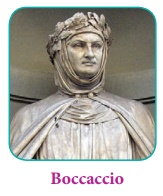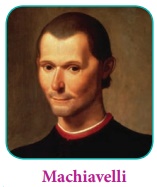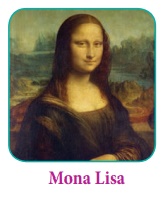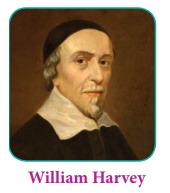Modern World: The Age of Reason | History - Renaissance in Italy and its Spread in Western Europe | 12th History : Chapter 10 : Modern World: The Age of Reason
Chapter: 12th History : Chapter 10 : Modern World: The Age of Reason
Renaissance in Italy and its Spread in Western Europe
Renaissance in Italy and its Spread in Western Europe
Significance of Renaissance
The word
Renaissance, of Latin origin, means rebirth or revival. It signifies the sudden
revival of interest in the classical learning of Greece and Rome. In the course
of development, however, the Renaissance became more than a mere revival of
classical learning. It included an impressive record of new achievements in
art, literature, science, philosophy, education, religion, and politics.
Renaissance incorporated a number of ideas. Notable among them were humanism,
scepticism, individualism, and secularism. A unique aspect of the Renaissance
was the contribution made not by monks and nobles, but by laypersons.
Causes of Renaissance
(i) New
experiences during the Crusades [religious wars aimed at recovering the Holy
Land from Muslim rule], the rise of independent trading cities like Venice,
Florence, Genoa, Lisbon, Paris, London, Antwerp, Hamburg and Nuremberg, with
many visiting travellers, and the establishment of universities at Paris
(France), Oxford (England), and Bologno (Italy) provided the necessary
preliminary conditions for the birth of renaissance.
(ii) Philosophical
discussion, which had begun as early as the eleventh century, continued to
produce great minds. The most prominent among them in the thirteenth century
was Roger Bacon (1214–1294). An Englishphilosopher who lived in Oxford,Bacon is
considered the father of modern experimental science. He wanted
human kind to be ruled not by dogma and authority but rather by reason.

(iii) In 1393, a famous scholar of Constantinople,
Manuel Chrysaloras, arrived in Venice on a mission from the Byzantine emperor
to seek the help of the West in the war against the Turks. Chrysaloras was
eventually persuaded to accept a professorship of Greek classics at the
University of Florence. About the beginning of the fifteenth century several
other Byzantine scholars migrated to Italy. The influence of these scholars
inspired Italian scholars to make trips to Constantinople and other Byzantine
cities in search of manuscripts. Between 1413 and 1423 one Giovanni Aurispa brought
back nearly 250 manuscript books, including the works of Sophocles, Euripides,
and Thucydides. After the fall of Constantinople in 1453 there was a great
exodus of classical scholars to Western Europe which gave a fillip to classical
learning.
(iv) The Byzantine world not only gave Christendom the stimulus of its scholars and philosophers, it also gave it paper. Though paper originated in China in second century BC (BCE)., it reached Germany only by the fourteenth century. Thereupon, the invention of moveable type and the printing press by Johannes Gutenberg followed. With printing, the intellectual life of the world entered a far more vigorous phase. Knowledge spread swiftly.
Italy as the birthplace of Renaissance
Renaissance began in Italian cities and later
spread to western Europe. Italians preserved the belief that they were
descendants of the ancient Romans. They looked back upon their ancestry with
pride. Italy had a more secular culture than most other parts of Latin Christendom.
The old cathedrals and paintings seemed to them gloomy and the old traditions
irksome. So in their search for something more to their liking, they discovered
books written in Latin. They learnt to write Latin as the ancient Romans did.
They also learnt Greek and thereby discovered wonderful works of the Athenians
of the time of Pericles and facilitated a rebirth of the ancient and the bygone
era of Greek and Roman culture. Italian universities were established primarily
for the study of law and philosophy.
The Medici Family: Florence is one of the city
states in Italy which was influenced by a powerful merchant family called
Medici. Cosimo de Medici who was engaged in banking with many branches across
Italy had indirect control over the functioning of the government between 1434
and 1464. After his death, his grandson Lorenzo took over and controlled the
government. He was known as Lorenzo, the Magnificent. During this period, the
Medici family patronised many artists including Michelangelo and Leonardo da
Vinci.
Italy was
situated in the centre of Mediterranean Sea and hence the Italian cities were
the main beneficiaries of the revival of trade with the East. By the fourteenth
century Italian cities engaged in sea-borne trade had become fabulously rich.
The Renaissance movement was accelerated by two prosperous families, the Medici
family in Florence and the Sforza family in Milan.
Popes
such as NicholasV, Pius II, Julius II and Leo X bestowed their patronage upon
the most brilliant artists of the Italian Renaissance.
Florence as Home of Renaissance
Renaissance in Literature

Even in
the thirteenth and fourteenth centuries Florence had produced Dante (1265-1321)
and Petrarch, the two great poets of the Italian language. Dante’s Divine Comedy is a summation of medieval
culture. Its dominant theme is the salvation of mankind through reason and
divine grace. But it abounds with many other themes such as human love, love of
country, interest in natural phenomena and even the desire for a free and
united Italian nation.
Petrarch
(1304-1374) produced works both in Latin and Italian. An early humanist, he is
considered to be the father of Italian Renaissance literature. Petrarch’s
inquiring mind and love of classical authors led him to travel, visiting men of
learning and searching in monastic libraries for classical manuscripts. It is
believed that his rediscovery of Cicero’s letters was a key moment in the 14th
century Italian Renaissance.

Giovanni
Boccaccio (1313–1375), also Florentine, produced Decameron, a collection of 100
stories, as told by seven young women and three young men, during their stay at
a villa outside of Florence to escape the ravages of the Black Death.
Niccolò Machiavelli (1469–1527)
Niccolò
Machiavelli’s The Prince became
famous because of its relevance as a political guide for the rulers. In his
view, the supreme obligation of the ruler was to maintain the power and safety
of the country over which he ruled. No consideration of justice or mercy or the
sanctity of treaties should be allowed to stand in his way.

Machiavelli
maintained that all men are prompted exclusively by motives of self-interest
and the head of the state should therefore take nothing for granted as to the
loyalty or affection of his subjects.
‘A
Prince’ says Machiavelli, ‘must know how to play at once man and beast, lion
and fox. He neither should nor can keep his word when to do so will turn
against him…. I venture to maintain that it is very disadvantageous always to
be honest; useful on the other hand, to appear pious and faithful, humane and
devout. Nothing is more useful than the appearance of virtue.’
Renaissance in Art
Leonardo da Vinci (1452–1519)
In Florence there was an artist who wanted to
have a perfect understanding of all the things he painted and how they related
to each other. This was Leonardo da Vinci, the son of a farm servant-girl. So
he was a self-taught
man in Latin and Mathematics. He was also a sculptor, a great thinker and
scientist. He got corpses from graveyards to dissect and understand human
anatomy so that he could depict human bodies realistically. He was the first to
discover that blood circulated through the body. Given his multifaceted talents
da Vinci is considered to be a great example of the Renaissance Man.

Leonardo da Vinci’s masterpieces include Virgin of the Rocks, Last Supper and Mona Lisa. In Virgin of the Rocks, the Virgin Mary, emerging from darkness, presents the young John the Baptist to the Christ Child. Supper (Jesus’s final meal with the apostles before his crucifixon) for the Dominican monastery in Milan. Mona Lisa, his most famous portrait, is believed to be the image of Lisa Gherardini, wife of a wealthy merchant from Florence, del Giocondo, who commissioned it.


Michelangelo (1475–1564)
Donatello
was one of the earlier artists to create a very realistic and majestic painting
of David, the Biblical hero in the 1460s. He influenced Michelangelo di
Lodovico Buonarroti Simoni who is considered to be the greatest Renaissance
sculptor. The Cathedral of St. Peters in Rome, built by the Popes, was
fashioned by Michelangelo. His dome of St. Peters, the realistic statue of
David, and the magnificent paintings on the ceilings of the Sistine Chapel are
outstanding examples of Renaissance art. He also sculpted the famous Pieta, a
statue of the Virgin Mary, grieving over the body of dead Christ. It was carved
out of a single marble stone from Carrera in Central Italy.

Raphael (1483–1520)
Raphael’s
famous work is Madonna and Child, where Virgin Mary and child Jesus are portrayed. Raphael painted the library
walls of Pope Julius II with various religious themes. One such theme was
School of Athens that highlighted the classical influence on the renaissance
art. He painted himself along with the paintings of Leonardo and Michelangelo.

Science and Technology
During
the fifteenth to the seventeenth centuries, science also developed rapidly
leading to a Scientific Revolution. Scientists of this period had to antagonise
the Church, for the Church did not like people to think and experiment, and
question god.

Nicolas
Copernicus (1473–1543), a Polish scientist, propounded the theory that the Sun
was at the centre of the solar system and all the planets including the earth
revolved around the sun (heliocentric). This was the opposite view of the
Church which propagated the earth-centric (geocentric) view. Any views that
opposed the Church’s ideas were considered heresy. Copernicus postponed the
publication of his work on the Revolutions
of the Celestial Spheres almost till the end of his life. Giordano Bruno,
an Italian, was burned in Rome by the Church in 1600 for insisting that the
earth went round the sun.

The most
important astronomical evidence for the heliocentric theory was furnished by
the great of astronomer Galileo Galilei (1564–1642). With a telescope, he
discovered the satellites of Jupiter, the rings of Saturn and the spots on the
sun. He was made the professor of Medicine and Maths by the Medici family at
the University of Padua (Republic of Venice). He made efforts to make science
stay detached from religion. He accepted the views of Copernicus who propounded
the heliocentric theory. He was tried for heresy by the Church and was kept
under house arrest.

Among the
prominent men of science in the sixteenth century William Harvey (1578-1657) was
one who finally proved the circulation of the blood in the human body.
Spread of Renaissance in Western Europe
Renaissance in England
The
renaissance had its impact not only in Italy but in many parts of Europe
including France and Germany. It left a deep imprint on England. The rule of
Elizabeth I (1558– 1603) came to be called the Elizabethan Age. The Elizabethan
Age produced many scholars during the English Renaissance. Notable among them
were William Shakespeare, Christopher Marlowe, and Francis Bacon. Christopher
Marlowe was an English playwright, whose important works include Dido, The Queen of Carthage, and Tamburlaine the Great.
The
greatest writer in English was William Shakespeare. Born at Stratford upon
Avon, he wrote 38 plays and many poems involving various human emotions namely
love, anger, tragedy, jealousy, and deceit. His comedy plays include As You Like It, The Taming of the Shrew,
and A Midsummer Night’s Dream while Othello, Hamlet, King Lear and Romeo
and Juliet are examples of
tragedies. His plays, performed in the Globe theatre in London were popular.
The plays had a profound impact on the English language, and when Britain
became an empire after the industrial revolution his plays spread across the
world.

Francis
Bacon is considered the father of empiricism. He argued that inductive
reasoning (an approach to logical thinking that involves making generalisations
based on specific details and is the opposite of deductive reasoning) is the
base for scientific knowledge. His most important work is Novum Organum, a philosophical work written in Latin. It deals with
methodical observation of facts as a means of studying and interpreting natural
phenomena.
Related Topics